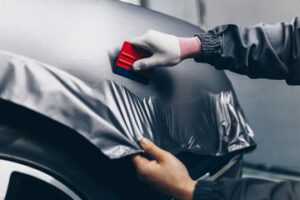Wraps are a great way to personalize your vehicle. They can also be used to promote a business or brand. They are durable and easy to maintain. They are also much cheaper than a paint job.

Vinyl wraps are available in different sizes. Some are designed to cover the entire vehicle, while others are smaller and can only be applied to some regions of the vehicle.
Car wraps are a versatile way to personalize your vehicle, whether you want to stand out in the crowd or make a statement. They’re available in a wide variety of colors and can be designed to include graphics, text, or even logos. They can also be used to protect the paint job on your vehicle, which can add value when it comes time to sell or trade in your car.
Wraps can be a quick and easy alternative to a traditional paint job. Unlike custom paint, wraps don’t need to dry and cure, and they can be removed in one piece. Moreover, they can be easily cleaned with mild pH-balanced soap and water.
When installing a wrap, be sure to use a quality installer. This will help prevent bubbles, wrinkles and other issues. It’s also important to follow the instructions carefully. For example, if you’re installing the wrap yourself, it’s a good idea to sketch out each panel and write down measurements for later. Likewise, it’s important to avoid applying the wrap over sharp or uneven edges.
Vehicle wraps are very durable, but they can still be damaged by environmental factors. Coastal salt air, bright sunlight, and trees that drop sap can all damage the vinyl. To extend the life of your wrap, it’s a good idea to store it indoors, park under the roof when possible, and not park under trees, like maple and elm, that are prone to sap.
In addition to changing the color of a vehicle, wraps can also be used to add texture. For example, brushed metal and carbon fiber wraps can add a unique look to a vehicle. The wraps can also be designed to reflect light in different ways, enhancing the visual impact of the design.
Car wrapping is a great option for commercial vehicles as well. For example, pizza delivery cars and landscaping trucks can be wrapped with their company logo or slogan to attract potential customers. Similarly, sports teams can wrap their buses with team logos and mascots to promote the brand. Additionally, paid promotional drivers can be hired to carry a company’s message in exchange for a fee.
They are a great way to promote your business or brand
Car wraps can be an excellent way to promote your business or brand. They can be customized with graphics, logos, and contact information to help customers identify your products and services. A professional designer can create a wrap that will catch the eye of potential customers while still being functional and maintaining the integrity of your vehicle’s shape. Wraps are also great for promoting your small business by turning your vehicle into a mobile billboard. They can spread awareness of your company while traveling on the road, and are a more cost-effective way to advertise than traditional billboards.
Many companies claim to pay drivers to put advertisements on their vehicles, but these claims are often scams. If a company claims to pay you for your advertisement, ask to see if it is registered in your state and has a good Better Business Bureau rating. Also, check its social media accounts to ensure that they are real.
A good vehicle wrap design should include large fonts and bright colors, to make it easy for other drivers to see. Also, avoid overlapping text or images, as they will be difficult to read from a distance. Also, choose designs that will stand out in the traffic, such as Innowave Energy’s bright green wrap. This will help drivers notice your car quickly, and it will make other motorists more likely to take note of your ad.
Another important consideration when designing a car wrap is the size of the window and doors. If the wrap is too large, it may block a driver’s vision while driving, and it will be hard to see your contact information. However, if the wrap is too small, it may not be readable or could be obscured by the door handle when the car is opened.
A well-designed car wrap can be a great marketing tool for your small business, but it’s also important to remember that a wrap is only as effective as the quality of the installation. A professional installer will properly prepare the vehicle for the wrap by removing any rust or other paint abnormalities that could interfere with the adhesive. They will also apply a primer to the surface of the vehicle, and will use a high-quality vinyl material that is weatherproof.
They are a cost-effective way to advertise
Car wraps are a cost-effective way for small businesses to advertise. They can be custom-designed to match your brand and message, and they can be easily switched out as the marketing needs of your business change. In addition, they can help you reach a wider audience. They are also more effective than other forms of advertising, such as radio and television commercials. In fact, according to Arbitron Inc, a leading international marketing research firm that serves outdoor media, radio broadcasters, television cable companies and advertising agencies in the United States and Europe, vehicle wraps are one of the most cost-effective forms of advertising.
A vinyl wrap is a great way to increase your brand visibility while keeping your vehicle’s paint job in pristine condition. In fact, it can be more cost-effective than traditional advertising. While there are a few drawbacks to using a wrap, such as the potential for the image to bleed through or scratch off, if you work with a reputable company that specializes in vehicle wrapping, it will not be an issue.
Another benefit of car wraps is that they can be used to promote multiple brands and services simultaneously. This can save you money and time, and it will also allow you to expand your reach. Unlike other advertising methods, car wraps allow you to spread your message without interrupting customers. This means that you can get more exposure for your business by driving around town or even traveling long distances to meet a customer.
Unlike most advertising methods, car wraps are long-lasting and can be easily replaced when necessary. In addition, they can be designed to complement any type of business, making them an excellent marketing solution for both local and national companies.
They are easy to install
Car wraps are a great way to protect and update your vehicle without the cost of paint. However, like any other vehicle, the wrap needs to be cared for. If it is properly installed and maintained, it can last up to seven years. It is important to have a good, experienced installer for your wrap because it is a difficult job that requires many tools. Doing it yourself can lead to overstretching, poorly matched seams, and loose corners.
It is also essential to keep your vehicle in a garage or covered parking area, as it will protect it from the sun’s UV rays and other environmental factors that can cause damage to the wrap. It is also wise to drive carefully on rough roads to avoid stirring up pebbles and rocks that could scratch the wrap.
Keeping your wrap clean is easy, but you will have to be patient since it will take some time to wash it. You will need to use a mild detergent and a soft cloth or sponge. Be sure to rinse thoroughly to minimize water spots. It is a good idea to wash your vehicle and wrap at least once a week. Washing it more often will help prevent dirt and pollutants from causing early degradation of your wrap.
The best way to maintain your wrap is by washing it regularly, especially if you live in a cold climate where road salt can damage the vinyl. You should also store it in a garage or covered parking space to protect it from rain and snow.
